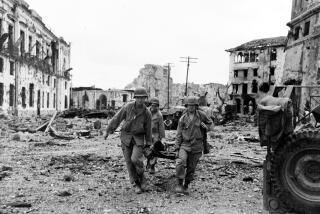An exit has opened for Aleppo’s trapped civilians to leave. But no one is using it

Los Angeles Times special correspondent Nabih Bulos reports from Aleppo, Syria.
- Share via
Reporting from Aleppo, Syria — Troops and aid workers milled around aimlessly, turning to glance at the road cutting through a berm in this desolate corner of northern Aleppo. To the side, a group of Russian soldiers huddled near a set of plastic lawn chairs, seeking shade under an umbrella.
Everyone seemed bored.
Since July, an estimated 250,000 people in the rebel-held eastern neighborhoods of Aleppo have lived under a punishing siege mounted by government forces.
As the battle rages between the troops and the rebels trapped inside, aid groups have begged for a break in the fighting to deliver humanitarian assistance they say is desperately needed.
Instead, Damascus, in cooperation with the Russian government, on Friday declared a cease-fire and opened several corridors for safe passage for those who wanted to leave the rebel enclave. It was the second time it had extended such an opportunity.
But as with the first attempt, it seemed there were few takers.
At this evacuation zone on the Castello highway, on the city’s northern periphery, there were no evacuees to be seen.
Civilians and rebels also had the option of using six other pathways during the ten-hour cease-fire from 9 a.m. to 7 p.m.
Russian military officials said it was the rebels’ final opportunity to leave the area unharmed.
Over the past several days, Syrian and Russian warplanes have dropped leaflets and sent text messages exhorting the fighters to “save themselves” or risk being “destroyed.”
Others messages urged residents “to stand as one man against terrorism” and not let “foreigners and strangers” control them and their families — a reference to Syrian President Bashar Assad’s long-standing contention that the war has been fueled by Syria’s regional and international enemies.
Pro-opposition activists have posted images on social media of what were said to be defiant eastern Aleppo residents using the leaflets as cigarette papers.
The nearly six-year war has killed an estimated 400,000 people and left much of Syria’s cities in ruins.
On Friday morning, aid workers sporting blue vests and hard hats from the Aleppo Residents’ Initiative, a local humanitarian organization, gathered alongside medics and security personnel at the Castello crossing.
Behind them stood 10 ambulances, 14 minivans and three large buses, ready to transport anyone who came from the other side. Two state judges stood by to oversee the legal proceedings for militants wishing to surrender.
The Syrian government has made an offer to rebels willing to lay down their arms that they will be reintegrated into areas under government control.
“Every person who hands over his weapon is included in the amnesty,” said Abdul Hamid Sayrafi, a judge and one of the heads of the Public Prosecutor’s office in Aleppo.
“This is for the public good, and our concerns are for the civilians still inside,” he said.
Under the amnesty plan, those who refuse to give up would be given the chance to make their way to the Syrian-Turkish border or to Idlib, a province west of Aleppo that has become the main rebel bastion in the country.
Also on hand Friday were two Muslim clerics.
“We came here to adjudicate between the two parties, and to guarantee the lives of the people coming out,” said Sheikh Abdullah Junaid.
Earlier, he had appeared on state media pleading with the rebels to leave the area. “I told them … ‘is it not enough bloodshed? We speak of freedom and social equality … is this it?’”
But the message appeared to have been lost on the rebels, who earlier in the week had launched a massive counteroffensive on Aleppo’s southwestern flank to punch through the blockade.
Halfway through the morning, no one had appeared at another crossing designated for the militants in Bustan Al-Qasr, a neighborhood on the edge of the line that has long divided Aleppo into areas of government and rebel control.
A view from a nearby tower showed the area to be all but deserted.
Troops stationed nearby, according to a military officer who refused to give his name for reasons of security, said the army was committed to the cease-fire and had not attacked eastern Aleppo, despite coming under fire from mortars and rebel snipers.
At the Castello crossing, the opposition did more than refuse to evacuate: In the early afternoon, two shells slammed close to where the authorities had massed.
Five more would fall, injuring two Russian soldiers and one Syrian state journalist, according to state media.
Meanwhile, rights groups warned of an impending disaster that could affect civilians on both sides of the city.
“Even in times of wars, there are fundamental rules that all parties must obey. Civilians must never be deliberately targeted,” Samah Hadid, deputy director for campaigns at Amnesty International’s Middle East office, said in a statement Friday.
She blamed the Syrian and Russian governments for “unlawful attacks,” including those using cluster munitions, that failed to protect civilians. Residents of western Aleppo, she added, were at risk “from the repeated unlawful use of explosive weapons.”
As the deadline passed, the heavy thud of ordnance rattled windows in the southwestern suburbs of the city. Aleppo’s eastern neighborhoods were shrouded in darkness.
Yet there was no ambiguity in either side’s position.
Rebel groups uploaded pictures of the fighting on social media, boasting of killing scores of pro-government troops and allied militiamen.
State TV, meanwhile, interspersed its news updates with a graphic emblazoned with text.
“Aleppo of steadfastness,” it declared.
Bulos is a special correspondent.
Follow @nabihbulos on Twitter.
ALSO
Armed civilians are joining the fight against Islamic State in Mosul, Iraqi officials say
3 U.S. military trainers killed at a Jordanian air base
Paris authorities clear thousands of migrants from makeshift camp known as ‘Stalingrad’
More to Read
Sign up for Essential California
The most important California stories and recommendations in your inbox every morning.
You may occasionally receive promotional content from the Los Angeles Times.











